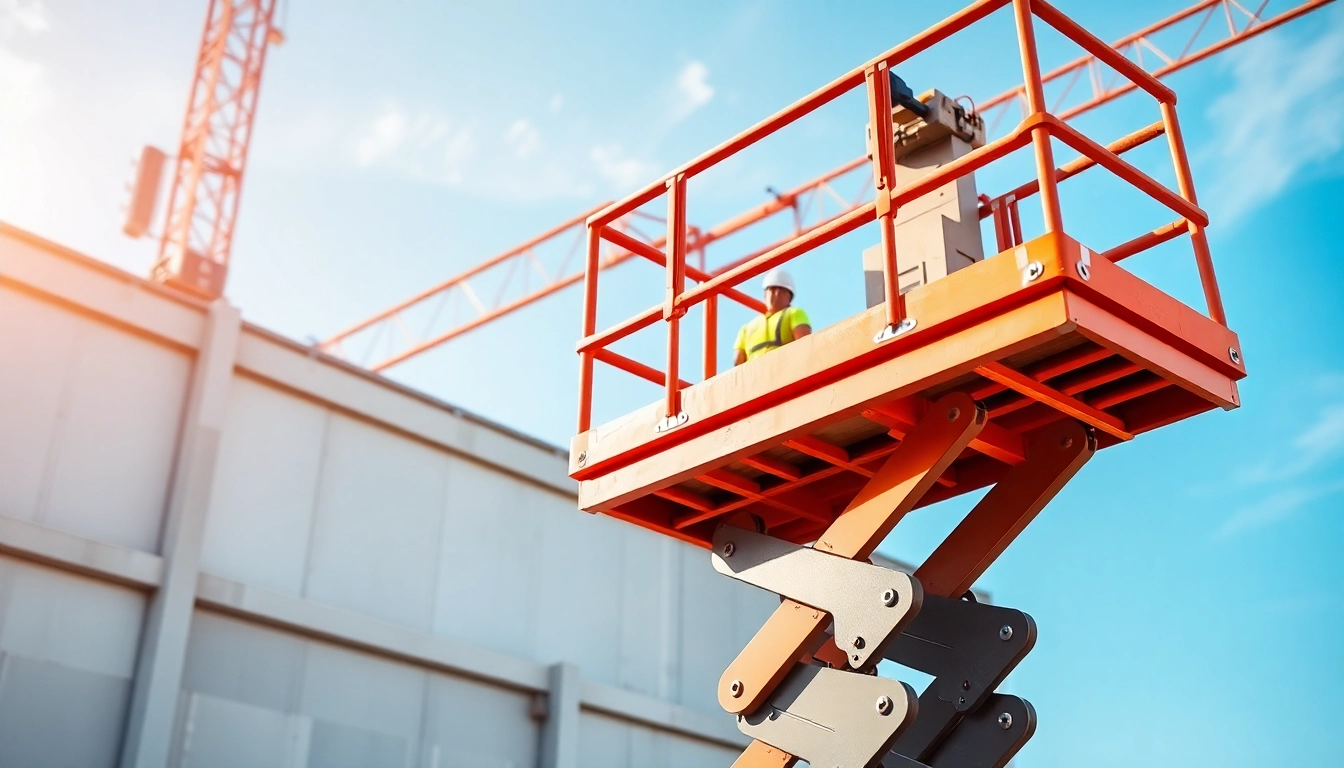Understanding Scissor Lift Rental: Types and Uses
Scissor lifts have become an indispensable piece of equipment across various industries, offering a safe and efficient way to work at height. Whether you’re involved in construction, maintenance, event setup, or industrial tasks, the ability to elevate workers and tools reliably is critical for productivity and safety. As the demand for versatile access solutions grows, so does the market for scissor lift rental. This comprehensive guide explores the different types of scissor lifts, their optimal applications, and how to choose the right rental service for your project.
Indoor vs. Outdoor Scissor Lifts: Choosing the Right Equipment
When selecting a scissor lift, the primary consideration is the environment in which it will be used. Indoor and outdoor lifts are designed with distinct features tailored to their specific operational contexts.
Indoor Scissor Lifts
Indoor models are compact, lightweight, and often electric-powered to minimize emissions, noise, and surface damage. They typically have smaller footprints and are designed to operate on smooth, level surfaces such as warehouse floors, retail spaces, or manufacturing facilities. Electric drives and narrow chassis make indoor lifts ideal for confined spaces where maneuverability is essential.
Outdoor Scissor Lifts
Designed to withstand harsher conditions, outdoor scissor lifts are equipped with rugged tires, larger platforms, and often diesel or hybrid engines for increased power and range. They feature higher ground clearance and robust construction to handle uneven terrain, wind, and weather. They are suitable for construction sites, outdoor maintenance, and large-scale industrial projects.
Matching the lift type to your environment not only ensures operational safety but also optimizes efficiency by reducing downtime and equipment wear.
Electric vs. Diesel: Pros and Cons for Rental Applications
The choice between electric and diesel scissor lifts hinges on factors such as environment, power requirements, and operational duration. Understanding their respective advantages and limitations helps in making an informed rental decision.
Electric Scissor Lifts
- Advantages: Zero emissions, near-silent operation, minimal maintenance, and suitability for indoor use.
- Limitations: Limited battery life, potentially lower speed, and less power for heavy-duty tasks.
Diesel Scissor Lifts
- Advantages: Greater power capacity, longer operational hours, and better suited for rough terrain and outdoor environments.
- Limitations: Emissions, noise, and higher maintenance costs, making them less suitable for enclosed or sensitive indoor spaces.
For indoor applications, electric lifts are generally preferred due to their clean operation. Conversely, diesel lifts excel in outdoor, rugged conditions where power and mobility are priorities.
Common Uses Across Industries: Construction, Maintenance, and Events
Scissor lifts are versatile and find applications across numerous sectors:
- Construction: Elevating workers and materials for tasks like drywall installation, electrical wiring, and facade work.
- Maintenance and Repairs: Accessing high ceilings, lighting fixtures, HVAC systems, or signage in commercial and industrial buildings.
- Events and Setup: Installing lighting, decorations, or banners at outdoor concerts, festivals, and trade shows.
The ability to customize lift height, platform capacity, and mobility options makes scissor lifts an invaluable asset for these industries.
How to Select the Best Scissor Lift Rental Service
Choosing a reliable rental provider ensures equipment safety, operational efficiency, and cost-effectiveness. Critical evaluation of rental companies and their offerings can significantly impact your project outcomes.
Assessing Equipment Quality and Safety Standards
Prioritize rental services that maintain their lifts according to manufacturer guidelines, regularly inspect machines, and comply with industry safety standards. Look for certifications and warranties that validate the lift’s reliability. For instance, credible providers perform routine safety inspections, adhere to national health and safety regulations, and keep logs of maintenance history.
Comparing Rental Costs and Contract Terms
Rental prices vary based on lift type, duration, and service provider. When comparing quotes, consider:
- Daily, weekly, and monthly rates
- Deposit requirements
- Distance or delivery charges
- Terms regarding damage, downtime, and liability
Always clarify what’s included in the rental cost to avoid unexpected expenses.
Evaluating Delivery, Setup, and Support Services
Delivery and setup are critical components of smooth project execution. Select providers that offer timely delivery, professional setup, and operator training if necessary. Responsive customer support and on-site assistance reduce delays, especially for complex or large-scale projects.
For example, providers like scissor lift rental services often include comprehensive support packages, ensuring your equipment functions optimally throughout your operational period.
Optimizing Your Project with Scissor Lift Rental
Strategic planning enhances safety, efficiency, and cost savings when utilizing rented scissor lifts. Properly leveraging the equipment can lead to faster project completion and improved safety standards.
Planning Access Points and Lift Capacity
Begin by assessing the exact access requirements—height, reach, and space constraints. Determine the maximum working height needed and the platform capacity for personnel, tools, and materials. Selecting a lift with slightly higher capacity and height margin provides flexibility for unforeseen needs.
Maximizing Safety and Compliance During Use
Ensure operators are trained on safe lift operation, including weight limits, stability precautions, and emergency procedures. Adhere to OSHA and local safety regulations, use safety harnesses if required, and perform pre-use inspections. Implement signage and safing zones to prevent unauthorized access.
Maintenance Tips for Rented Scissor Lifts
Although rental companies handle primary maintenance, operators must perform daily checks for oil leaks, tire condition, battery levels, and platform integrity. Maintaining cleanliness and reporting issues promptly prevent accidents and prolonged downtime.
Cost Factors and Budgeting for Scissor Lift Hire
Understanding the various cost components helps in effective budgeting and cost control for your project.
Daily, Weekly, and Monthly Rental Rates
Rental rates are typically structured based on the duration. Short-term rentals (daily or weekly) can be cost-effective for one-off projects, while long-term rentals (monthly) offer discounts and stability for ongoing operations. For example, electric scissor lifts may cost approximately £175–£240 per week, depending on the model and supplier.
Additional Costs: Transport, Setup, and Insurance
Additional expenses often include delivery charges, platform setup, operator training, and insurance. Some providers include these in the quote, while others bill separately. Insurance is crucial to mitigate liability in case of accidents or damage.
Strategies for Cost-Effective Rental Planning
Maximize rental value by:
- Booking equipment for the optimal duration—avoid unnecessary extended rentals.
- Opting for multi-week or monthly contracts if the project duration is predictable.
- Consolidating equipment needs to reduce delivery costs and ensure compatibility.
Consulting with a professional rental agency can also help identify the most economical options tailored to your specific needs.
Performance Metrics and Improving Efficiency
Tracking performance and safety indicators ensures your rental investment delivers maximum value and minimizes risks.
Monitoring Rental Equipment Utilization
Use maintenance and operational logs to track usage hours, identify patterns, and schedule timely inspections. Advanced lifts with telematics or RFID systems provide real-time data on usage, helping optimize allocation.
Ensuring Safety and Reducing Downtime
Regular safety drills, proper operator training, and pre-emptive maintenance reduce accident probability and machine failures. Maintaining a checklist for daily inspections ensures consistent safety standards. Rapid response support from the rental provider can address issues without costly delays.
Case Studies: Successful Scissor Lift Rental Projects
For example, a renovation project in central London utilized electric scissor lifts to access high ceilings efficiently. By coordinating rental timelines and leveraging the provider’s support, the project completed ahead of schedule with zero safety incidents. Such case studies highlight that strategic planning and partnership with reliable providers significantly enhance project outcomes.








